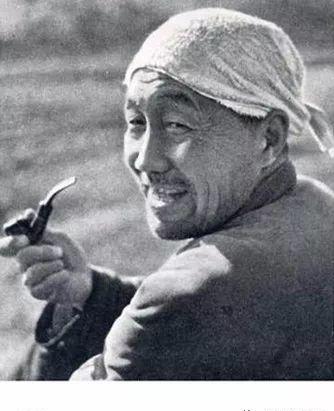In the 1980s, huaxian peasant calligraphy was highly valued by leaders at all levels and cultural and artistic circles. These native peasant calligraphers in Huaxian often used calligraphy as an art form to praise the party and socialism. On the eve of the Spring Festival, these peasant calligraphers took the initiative to go to the streets of the county town and the courtyards of the village heads, volunteered to write the Spring Festival League to thousands of households, and used the art of calligraphy to reflect the rich and colorful lives of the peasants. At the Shaanxi Provincial Rural Culture Work Conference held in Huaxian in December 1987, provincial leaders and experts and scholars from the cultural and artistic circles visited the exhibition of peasant calligraphy in Huaxian County, and fully affirmed the formulation of "peasant paintings in West Youhu County and calligraphy in HuaXian County in the east" in Shaanxi. --Li Bingwu
Peasant calligrapher - Wu Yukun
Wu Yukun, born in 1917 in Qiaojiapu (in present-day Lianhuasi Town), Huaxian County, moved to Wujia Village (in present-day Xiamiao Town) at the age of 10 to succeed his uncle, and died of illness in November 1986. Wu Yukunsheng was a former member of the provincial and county CPPCC committee, a member of the Chinese Calligraphers Association, a director of the Xi'an Calligraphy and Painting Research Association, and an honorary chairman of the Weinan Regional Calligraphy and Painting Association.

Wu Yukun Wu Ying provided
He loved calligraphy from an early age, but was forced to drop out of school when he was a teenager because of his family's poverty. Although he was tired of his livelihood and displaced by his adult life, his will to practice calligraphy assiduously was always unswerving. After liberation, life was stable, he ploughed in the countryside when he was busy, and read and learned words in his spare time.
He had a lacquer plate for practicing words, and for decades, he practiced writing on it every day, writing and rubbing, so that the wood of the lacquer plate was ground to a thick layer. He also often wrote on the ground with his fingers, and due to long-term hard practice, his thumb, index finger and middle finger were worn out in a layer of calluses.
Wu Yukun's calligraphy works
At first, he copied the calligraphy of Yan Zhenqing, Liu Gongquan, Zhao Mengshun, and Ouyang Qian, and later learned the wild grass of Huai Su and Zhang Xu, and his favorite and most deeply affected was Yu Youren's cursive.
He believed that the study of calligraphy should be based on the strengths of all families and not be confined to a single genre, so he conducted a comprehensive study and discussion of the writings of famous artists such as Wang Xizhi, Liu Gongquan, Su Shi, Zhao Mengfu, and Yan Zhenqing. Finally, it has a unique path and becomes a self-contained, forming a simple, rigid and pure style.
His calligraphy works have been exhibited in Japan twice, and he has participated in exhibitions in Xi'an and Beijing many times, and he has been introduced in people's pictorial, people's China, Hong Kong's Ta Kung Pao, Hong Kong's Wen Wei Po and Macao Daily, praising him as a "peasant calligrapher".
People's Pictorial, No. 6, 1974
In the late 1970s, the Shanghai Film Art Studio also made a short film for Wu Yukun's calligraphy art, "The Flower of Art". Many of his works have been exhibited in Japan, Europe, the United States and other places.
Source: Synthesized from "Hua County Chronicle", "Hua County Peasant Calligraphy"
Compilation and editing: Huazhou Literature and History Collection